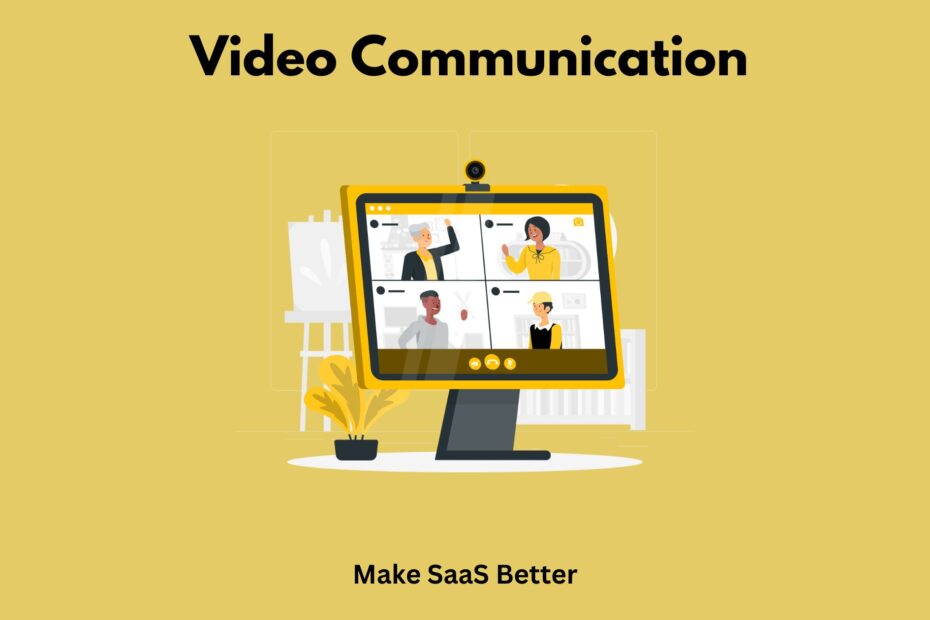The world doesn’t wait. People crave connection. Not just words on a screen, but real presence. Video communication makes it happen.
Forget those slow, endless text chains of yesterday. Now, you see the person. You catch their expression. It’s like you’re in the same room, even when you’re not. This isn’t just an idea. The data confirms it.
The global video conferencing market hit $14.2 billion in 2024. It’s set to keep growing. Paid subscriptions 2X through 2025. This isn’t a trend; it’s the new standard. Over 86% of remote workers use video tools weekly.
Young adults, 18-34, prefer video calls over phone calls, 78% of them. Businesses love it too. Companies with hybrid models use at least two video platforms. It’s not just for work. It’s how we live.
What Is Video Communication?
Video communication is simple: you talk, you see. It’s real-time interaction using both sound and visuals. Think of it as mimicking a face-to-face chat, but through a screen. It needs a camera, a microphone, and an internet connection. Your phone, your laptop, your tablet – all do the trick. The idea began with early television, sending images and sound across distances.
Now, it’s commonplace. It’s a bridge, connecting people regardless of where they are. This tech lets families stay in touch, friends connect, and businesses run smoothly with remote teams. It’s about being there, without actually being there.
Types of Video Communication
1. Point-to-Point Video Communication
This is a direct link between two individuals. Imagine a one-on-one video call, like a private chat. It’s simple. You and one other person. This setup is great for quick conversations, interviews, or focused discussions where only two participants are needed. It establishes a direct channel for clear, private interaction.
2. Multi-Point Video Communication
This is for groups. More than two people in a single call. Think team meetings, online classes, or large virtual gatherings. The software connects multiple participants, allowing everyone to see and hear each other. The number of people can vary, often exceeding 25 users, depending on the platform. It’s how groups stay connected and collaborate from different places.
3. Desktop Video Communication
This type happens right from your computer or laptop. You use software like Zoom or Google Meet on your desktop. It’s common for individuals and smaller teams. Easy to set up, just open the app and join. It offers flexibility to attend meetings from your usual workspace.
4. Room-Based Video Communication
This uses dedicated equipment in a physical meeting room. Large screens, specialized cameras, and high-quality microphones are installed. It creates a more formal, high-definition meeting experience, making it feel like everyone is in the same room. Companies use this for important group meetings or presentations.
5. Web-Based Video Communication
This runs directly in your internet browser. No need to download special software. You just click a link, and you’re in. It’s convenient for quick meetings or for people who don’t want to install new programs. Many services now offer this, making access easy and instant.
6. Mobile Video Communication
This is video calls on the go. Using your smartphone or tablet. It gives you the freedom to connect from anywhere with internet access. It’s perfect for busy people who need to join meetings while traveling or when away from their desk.
Benefits of Video Communication
1. Better Connection
Seeing faces makes a difference. You pick up on body language, expressions. This creates a real connection, something beyond just words. It builds trust. It makes conversations feel more human. People feel more involved when they can see who they are talking to.
2. Saves Time and Money
No travel needed. No flights, no hotel stays. This cuts down on expenses for businesses. It also saves hours. Time spent commuting, time spent waiting. Video meetings mean you join from where you are. Companies save about 30% in travel costs by using virtual meetings. That’s real money.
3. Increases Productivity
When people can see each other, they stay more focused. Fewer distractions. Quick decisions happen. Remote workers often report higher productivity with video tools. 76% of professionals say video meetings boost productivity and engagement. It helps get things done faster.
4. Global Reach
Connect with anyone, anywhere. Time zones become less of a barrier. Businesses work with teams across countries. Individuals keep in touch with family far away. Video communication shrinks the world. It makes distant relationships viable.
5. Real-time Sharing
Show, don’t just tell. Screen sharing lets you display documents, presentations, or anything on your screen. You can work on things together, live. It makes collaboration simple and fast. This clarity helps avoid misunderstandings and keeps projects moving.
5 Best Video Communication Tools
1. Zoom
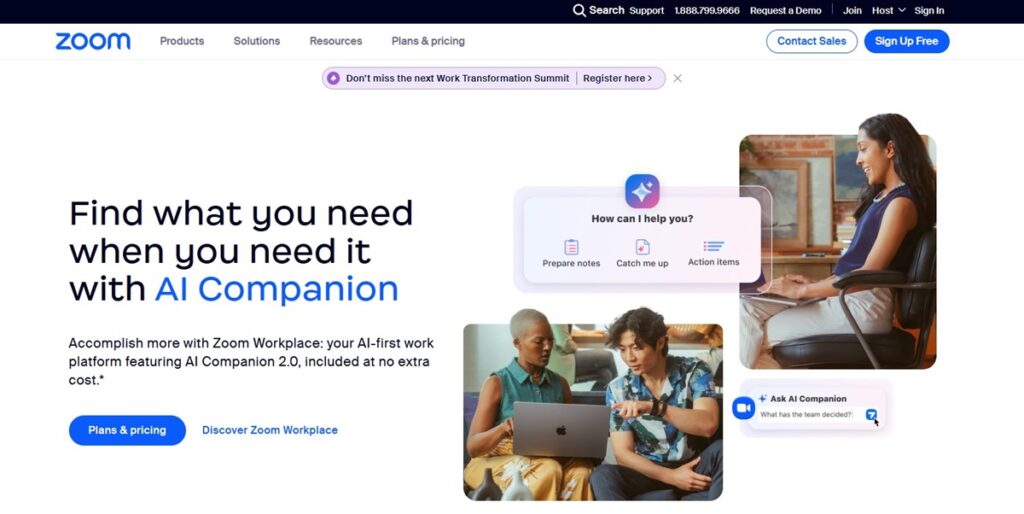
Zoom is the top video conferencing platform. It makes remote work, education, and social calls easy. It builds great virtual meetings, making faraway talks feel close.
Why Choose Zoom?
Zoom works. Competitors like Microsoft Teams and Google Meet have improved, but Zoom’s strong name for good video and sound remains. It’s about being simple and performing well. This lets you focus on what’s important.
As a host, you get great control. You can manage your virtual space very well. Zoom also connects with other services easily. This means less trouble and better workflow, which helps you get things done.
Standout Features
Zoom’s features make virtual talks feel natural. Think clear video, simple screen sharing, fun virtual backgrounds, and breakout rooms for focused chats. These tools make your meetings interesting and useful.
Integrations
Zoom works well with other big programs. It connects with Microsoft Outlook, Google Calendar, Salesforce, and HubSpot. This means less switching apps and more steady work in your current setup.
Latest Advancements
Zoom is pushing AI. Their AI Companion does more than take notes. It’s becoming an agent that can handle tasks and perform hard actions for you. They are also adding agentic AI across their platform, like an AI-powered Virtual Agent 2.0 for customer help, which can finish tasks on its own.
Pros:
- Many people know and use it, so it’s simple to invite others.
- It can hold many people.
- Easy screen sharing.
Cons:
- Some advanced features cost extra.
- Chat can feel basic for ongoing team talks.
- Had security issues before, but they are fixed.
Pricing
Zoom has a free plan. It has a 40-minute limit for meetings with three or more people. Paid plans start at $13.33/month/user if you pay yearly.
G2 User Score – 4.6 out of 5 stars
2. Microsoft Teams
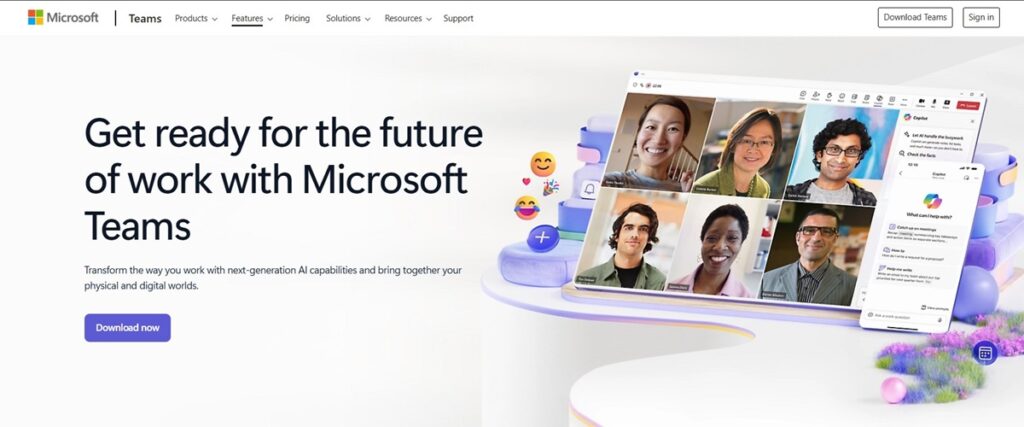
Microsoft Teams is a central place for teamwork. It brings together chat, video calls, and file sharing. It helps your team stay connected and work well, no matter where they are.
Why Choose Microsoft Teams?
Teams stands out because it works deeply with Microsoft 365. You get many tools in one spot. Other platforms offer communication. Teams combines communication, document creation, and project tasks into one smooth experience. It handles big company needs and also helps smaller teams.
Its design is formal and organized, for serious work. You get strong controls and security. This keeps your data safe. This focus on business needs gives Teams an advantage. This is true for businesses where security and a structured way of working are more important than just quick chats.
Standout Features
Teams has strong features. These include live captions, screen sharing with presenter views, and breakout rooms for focused talks. It also has ongoing chat, file sharing, and good meeting controls. All of these make working together easier and better.
Integrations
Its real strength comes from its many connections. Teams links directly to Microsoft 365 apps like Word, Excel, PowerPoint, and Outlook. It also connects with many other tools. These include Trello, Jira, GitHub, Zoom, Salesforce, and HubSpot. This makes it a very useful platform for many ways of working.
Latest Advancements
Microsoft Teams keeps getting better fast. Recent improvements include a single chat and channels view for simpler talks. It also has better controls for breakout rooms and closer ties with Outlook for meeting management. A big push is in AI. Copilot makes meeting summaries and smart notifications to show what matters most. Look for more engaging experiences with 3D avatars and spatial audio.
Pros:
- Good audio and video quality
- Strong connection with Microsoft 365 apps
- Solid security and compliance options
Cons:
- Can use a lot of computer power, slowing things down
- The interface can seem busy for new users
- Setting it up can take time
Pricing
Microsoft Teams has a free plan for basic chat and calls. Paid plans, like Microsoft Teams Essentials, start at ₹115.00 per user/month (paid yearly).
G2 User Rating – 4.4 out of 5 stars
3. Google Meet
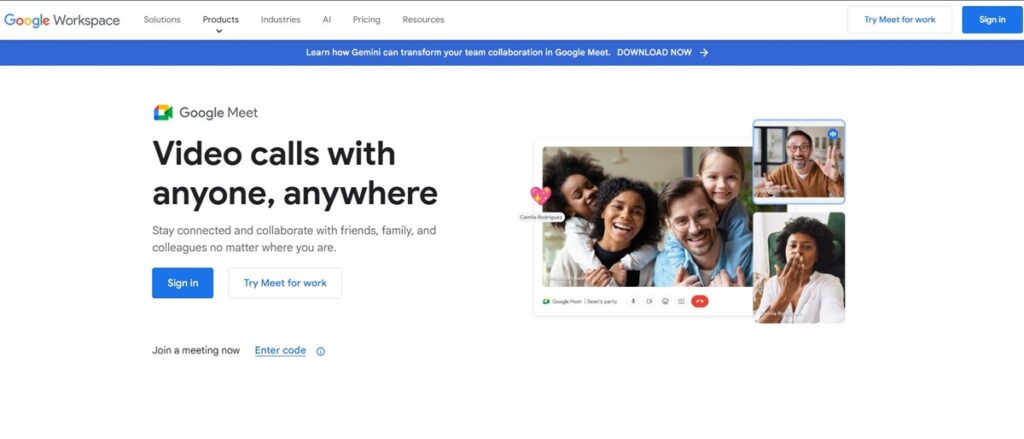
Google Meet is for video calls and teamwork. It’s built into Google Workspace. This means it’s easy for anyone to connect, for work or personal use.
Why Choose Google Meet?
Google Meet works with tools you already use. Schedule a meeting on Google Calendar. Join a call from Gmail. It all just happens. This makes work easier. You stay focused. Your Google apps all feel the same.
Other platforms exist, but Meet is simple and reliable. Especially for Google users. No extra software to get. Clear sound and video, even on slow internet. It helps you get things done.
Standout Features
Meet has the basics: good video and sound, screen sharing, live captions, and breakout rooms. It has host controls for people, polls, and Q&A. The focus is on a clear, useful experience for good talks.
Integrations
Its real strength is how it connects. Google Calendar for scheduling. Gmail for invites. Work together in Google Docs, Sheets, and Slides. Beyond Google, Meet connects with tools like Calendly, HubSpot, Slack, and Salesforce. It also works with many others using Zapier. This makes the workflow smooth.
Latest Advancements
Google Meet keeps getting better. New layouts use AI to show people better. Faces are front and center. New AI from Gemini in Workspace takes notes. It offers live translation. It even fixes sound and video problems automatically. You can just focus on talking.
Pros:
- Works well with Google Workspace
- Easy to use
- Good sound and video
Cons:
- Fewer advanced features than some others
- Some good features cost money with a Google Workspace plan
- Breakout room controls can be tricky
Pricing
Google Meet has a free plan. Up to 100 people. Group calls can last 60 minutes. Paid Google Workspace plans begin at $6/user/month.
G2 User Rating – 4.6 out of 5 stars
4. Slack
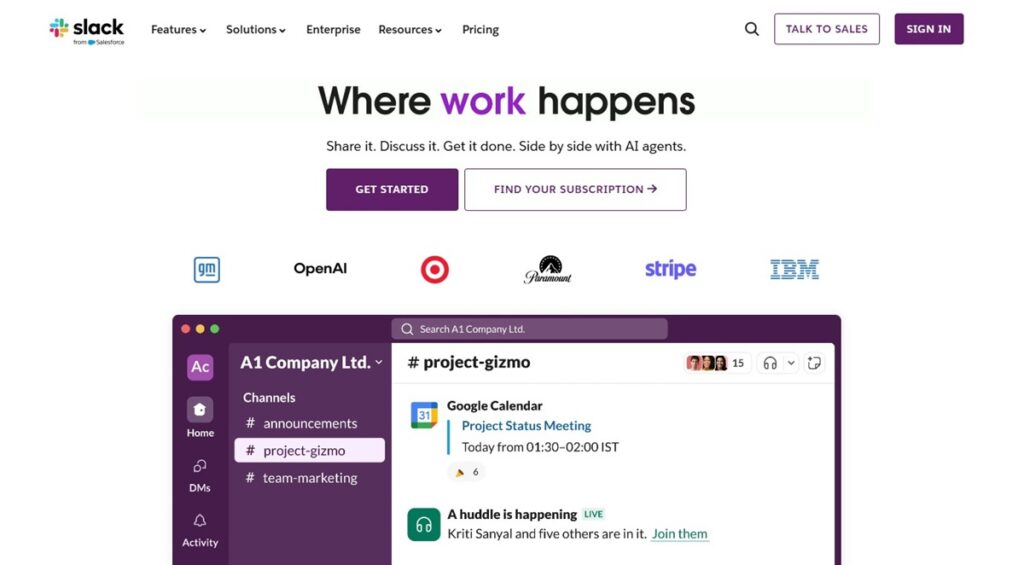
Slack is a digital workspace. It links people, tools, and information. It’s known for organizing talks into channels. This makes real-time chat and sharing files easy for teams. It’s where work happens. It makes getting things done simpler.
Why Choose Slack?
Slack brings all your communication to one spot. This cuts down on messy emails and scattered messages. Its easy-to-use design and channels keep talks focused. It also saves a searchable record of everything. So, you spend less time looking for info and more time working together.
It’s made for speed and clarity. You can jump into quick audio or video calls. You can share files fast. It connects with many other tools. This means less switching between tasks and more getting work done. Slack is not just about chat. It’s about making work easy.
Standout Features
Slack’s best features include its strong search. You can find any message or file quickly. Huddles offer instant audio and video calls for quick chats. Canvas gives a flexible space for shared documents and project plans. The Workflow Builder automates daily tasks. It’s a simple way to do more without code.
Integrations
Slack connects with many tools. Popular ones are Google Drive, Zoom, Trello, Asana, and Salesforce. This lets you bring your current ways of working right into Slack. Notifications, file sharing, and task management can all happen without leaving your main communication spot.
Latest Advancements
New updates in Slack focus on AI. “Slack AI” offers AI-powered search for quicker answers. It also gives instant summaries of talks. This helps teams catch up fast and stay informed without reading every message.
Pros:
- Talks are neat through channels and threads.
- Search works well and is quick.
- It connects well with other business tools.
Cons:
- Too many notifications can be a lot.
- Options for writing messages are basic.
- Cost can grow for big teams on paid plans.
Pricing
Slack has a free plan. It keeps messages for 90 days and has few connections. Paid plans begin at $7.25 per person each month if paid yearly.
G2 User Rating – 4.5 out of 5 stars
5. GoTo Meeting
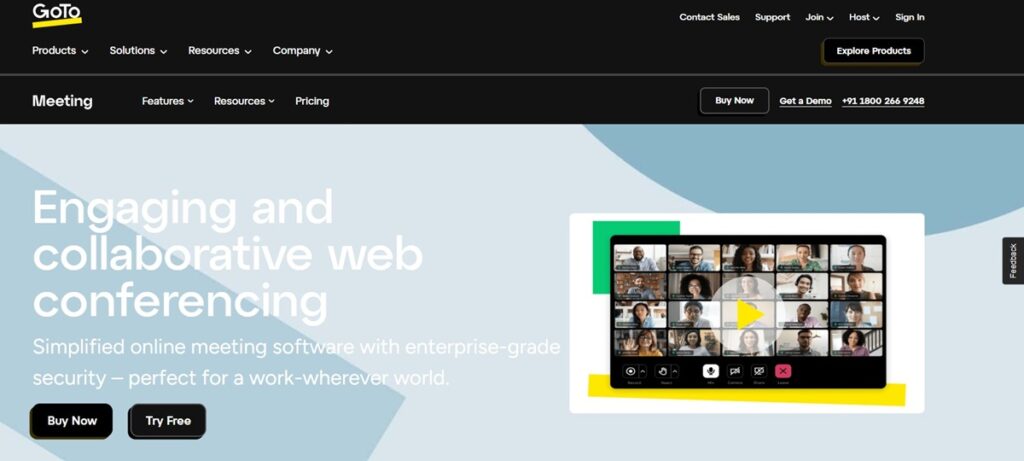
GoTo Meeting is dependable online meeting software for pros. It’s known for stable video and audio. This makes virtual meetings easy for any business. It keeps things clear and simple, avoiding complicated setups.
Why Choose GoTo Meeting?
Pick GoTo Meeting for solid virtual meetings. It always gives clear audio and HD video. This cuts down on tech problems. No more dropped calls or bad sound; GoTo Meeting simply works.
This tool stands out because it offers unlimited cloud storage for meeting recordings on paid plans. This is big for businesses that need to save every session. Other tools charge for storage, but GoTo Meeting lets you record all you want. This is smart for training or checking compliance.
Standout Features
GoTo Meeting has key features like screen sharing, breakout rooms for focused work, and drawing tools to mark up shared content. It also has a meeting lock and password protection to keep talks private. You can join meetings with one click, saving time.
Integrations
The tool works well with other business software. It connects with Google Calendar and Outlook for easy scheduling. It also links with CRM systems and Microsoft Active Directory for simple user setup.
Latest Advancements
Recent updates for GoTo Meeting include better stability and performance, especially for screen sharing on Windows. The desktop app also got zoom in/out support. The goal is to make the experience smoother and more responsive for users.
Pros:
- Easy to connect and join meetings
- Good audio and video quality
- Unlimited cloud recording and storage on business plans
Cons:
- Older-looking interface compared to some rivals
- Few collaboration tools, like whiteboards in some plans
- Screen sharing can sometimes lag
Pricing
GoTo Meeting has a free plan. It lasts 40 minutes and holds up to three people. Paid plans start at $12 per organizer each month.
G2 User Rating – 4.2 out of 5 stars
Conclusion
Video communication. It’s not a trend. It’s the new operating system for human connection. You want to truly connect? You use video. You want to get work done, no matter where your team is scattered? Video.
The data isn’t lying. Distances used to be a wall. Now, they’re just a screen. You save cash. You save time. You pull more out of every interaction.
This isn’t the future. This is now. Stop waiting. Connect. Be seen. It’s how you win.
